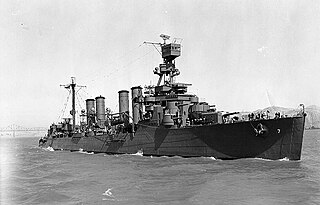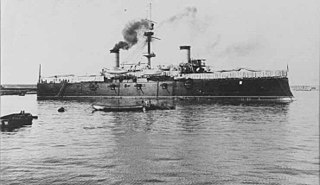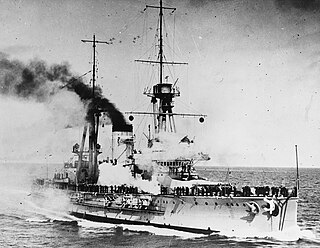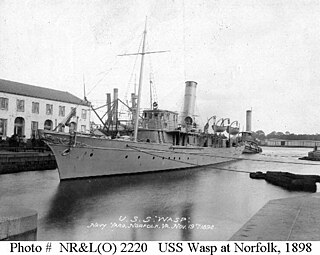
USS Oregon (BB-3) was the third and final member of the Indiana class of pre-dreadnought battleships built for the United States Navy in the 1890s. The three ships were built as part of a modernization program aimed at strengthening the American fleet to prepare for a possible conflict with a European navy. Designed for short-range operations in defense of the United States, the three Indiana-class ships had a low freeboard and carried a main battery of four 13-inch (330 mm) guns in a pair of gun turrets. Oregon and her sister ships were the first modern battleships built for the United States, though they suffered from significant stability and seakeeping problems owing to their small size and insufficient freeboard.

USS New York (ACR-2/CA-2) was the second United States Navy armored cruiser so designated; the first was the ill-fated Maine, which was soon redesignated a second-class battleship. Due to the unusually protracted construction of Maine, New York was actually the first armored cruiser to enter U.S. Navy service. The fourth Navy ship to be named in honor of the state of New York, she was later renamed Saratoga and then Rochester. With six 8-inch guns, she was the most heavily armed cruiser in the US Navy when commissioned.

The Battle of Santiago de Cuba was a decisive naval engagement that occurred on July 3, 1898 between an American fleet, led by William T. Sampson and Winfield Scott Schley, against a Spanish fleet led by Pascual Cervera y Topete, which occurred during the Spanish–American War. The significantly more powerful US Navy squadron, consisting of four battleships and two armored cruisers, decisively defeated an outgunned squadron of the Royal Spanish Navy, consisting of four armored cruisers and two destroyers. All of the Spanish ships were sunk for no American loss. The crushing defeat sealed the American victory in the Cuban theater of the war, ensuring the independence of Cuba from Spanish rule.

USS Raleigh (CL-7) was the fourth Omaha-class light cruiser, originally classified as a scout cruiser, built for the United States Navy. She was the third Navy ship named for the city of Raleigh, North Carolina. The first being Raleigh, a 32–gun frigate built in 1776, during the American Revolution, and captured by the British in 1778. The second was the protected cruiser Raleigh, commissioned in 1894, and decommissioned in 1919.

The second USS Marblehead (C-11/PG-27) was a Montgomery-class unprotected cruiser in the United States Navy, authorized in the naval appropriations bill of September 7, 1888. Marblehead served in the Spanish–American War and World War I, and was the last ship of her class in service.

SMS Kaiserin und Königin Maria Theresia was an armored cruiser used by the imperial Austro-Hungarian Navy from 1895 to 1917; she was the first ship of that type built by the Austro-Hungarian Navy. The ship was a unique design, built by the Stabilimento Tecnico Triestino shipyard in Trieste; she was laid down in July 1891, launched in April 1893, and completed in November 1894. Armed with a main battery of two 24-centimeter (9.4 in) guns and eight 15 cm (5.9 in) guns, the ship provided the basis for two subsequent armored cruiser designs for the Austro-Hungarian Navy.

Reina Mercedes, was an Alfonso XII-class unprotected cruiser of the Spanish Navy.

Almirante Oquendo, was an Infanta Maria Teresa-class armored cruiser of the Spanish Navy that fought at the Battle of Santiago de Cuba during the Spanish–American War.

Infanta María Teresa was the lead ship of her class of armoured cruiser constructed for the Spanish Navy. The ship fought at the Battle of Santiago de Cuba during the Spanish–American War.

Cristóbal Colón was a Giuseppe Garibaldi-class armored cruiser of the Spanish Navy that fought at the Battle of Santiago de Cuba during the Spanish–American War.

Gravina was a Velasco-class unprotected cruiser of the Spanish Navy.

Don Juan de Austria was a Velasco-class unprotected cruiser of the Spanish Navy that fought in the Battle of Manila Bay during the Spanish–American War.

The Velasco class of unprotected cruisers was a series of eight cruisers built during the 1880s for service with the Spanish Navy. They were named after Luis Vicente de Velasco.

Alfonso XIII was the second of three España-class dreadnought battleships built in the 1910s for the Spanish Navy. Named after King Alfonso XIII of Spain, the ship was not completed until 1915 owing to a shortage of materials that resulted from the start of World War I the previous year. The España class was ordered as part of a naval construction program to rebuild the fleet after the losses of the Spanish–American War; the program began in the context of closer Spanish relations with Britain and France. The ships were armed with a main battery of eight 305 mm (12 in) guns and were intended to support the French Navy in the event of a major European war.

USS Isla de Cuba was a Isla de Luzón-class protected cruiser of the United States Navy captured from the Spanish Navy during the Spanish–American War. Originally named Isla de Cuba for the Spanish colony of Cuba, the ship was ordered from the British shipbuilding company Sir W.G. Armstrong Mitchell & Company in January 1886 and laid down on 25 February 1886. The ship was launched on 11 December 1886 and completed in 1887. The vessel fought in the Rif War before being assigned to Spain's fleet in the Philippines. When the Spanish fleet in the Philippines was attacked by the United States Navy during the Battle of Manila Bay, Isla de Cuba was scuttled to prevent capture. However, the Americans raised the ship and commissioned her into the United States Navy in 1900 and assigned to the Asiatic Station, keeping the same name. In US service, the ship, rerated as a gunboat, was used to suppress the Philippine Revolution. The vessel was taken out of American service in 1904, becoming a school ship. In 1912, the US sold the ship to Venezuela which renamed her Mariscal Sucre. The ship was scrapped in 1940.

The seventh USS Wasp was the former yacht Columbia, purchased by the U.S. Navy and converted to an armed yacht serving from 1898 to 1919, with service in the Spanish–American War and World War I.

Almirante Cervera was a light cruiser and lead ship of the Almirante Cervera class of the Spanish Navy. She was named after the Spanish admiral Pascual Cervera y Topete, commander of the Spanish naval forces in Cuba during the Spanish–American War. She was part of the Spanish Republican Navy between 1931 and 1936, year in which she became a key player of the Nationalist Fleet in the Spanish Civil War.

Baleares was a Canarias-class heavy cruiser of the Spanish Navy whose control was taken by the Nationalist side during the Spanish Civil War. The two ships of the class were built upon a British design and were a modified version of the Royal Navy′s County class. Baleares was constructed in Spain by the Vickers-Armstrongs subsidiary Sociedad Española de Construcción Naval, and saw service during the Spanish Civil War, when she was torpedoed and sunk by destroyers of the Spanish Republican Navy during the Battle of Cape Palos.

The Cincinnati-class cruisers were two small protected cruisers built for the United States Navy in the early 1890s. They were smaller and more lightly armed and protected than most previous US cruisers, and were intended for commerce raiding. They may also be referred to as Raleigh-class cruisers, as Raleigh was launched and commissioned prior to Cincinnati.

The Montgomery-class cruisers were three unprotected cruisers built for the United States Navy in the early 1890s. They had a thin water-tight protective deck, and also relied for protection upon their coal bunkers, cellulose packing, and numerous compartments. Roomy accommodations were provided for officers and crew, these cruisers being mainly intended for long cruises on distant stations.


















